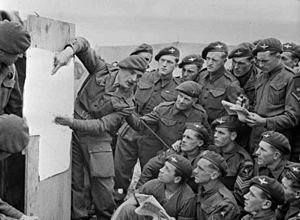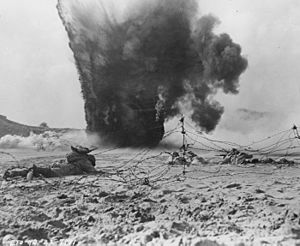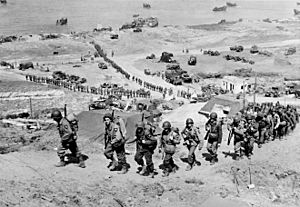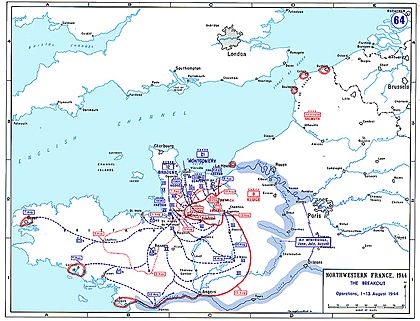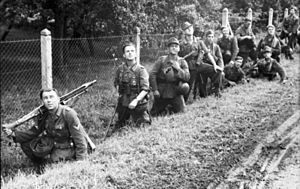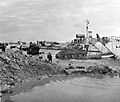Operation Overlord facts for kids
Quick facts for kids Operation Overlord |
|||||||
|---|---|---|---|---|---|---|---|
| Part of World War II | |||||||
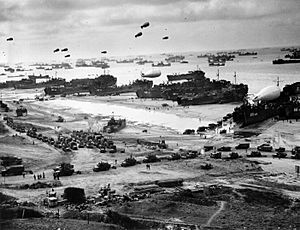 Tank landing ships unloading on Omaha Beach |
|||||||
|
|||||||
| Belligerents | |||||||
|
Allies |
|
||||||
| Commanders and leaders | |||||||
|
|
|||||||
| Strength | |||||||
| 1,332,000 (by July 24) | 380,000 (by July 23) | ||||||
| Casualties and losses | |||||||
| July 24: ~120,000 casualties |
July 24: 113,059 casualties |
||||||
Operation Overlord was a huge military plan during World War II in 1944. It was the secret name for the Battle of Normandy. This battle was fought by the Allied forces against German forces.
The most important part of Operation Overlord was the Normandy landings. This was when Allied armies landed on the beaches of Normandy, France. It was a very risky plan, and many soldiers were expected to be hurt or killed. But it worked! The Battle of Normandy continued until German forces left the area on August 30, 1944. This marked the end of Operation Overlord.
The main Allied forces came from the United States, United Kingdom, and Canada. Soldiers from nine other countries also joined. These included Australia, Belgium, Czech Republic, France, Greece, the Netherlands, New Zealand, Norway and Poland.
Operation Overlord was the largest water-to-land attack in history. Almost three million troops crossed the English Channel from England to Normandy. At that time, Normandy was controlled by Germany.
Contents
Planning the Invasion
Allied troops practiced many times to get ready for the landings. They needed to know how to land on the beaches.
Special maps of Normandy beaches were made. Planners knew that heavy tanks could not drive on some beaches because of soft ground. They planned to lay down special mats where the ground was soft.
On April 7 and May 15, Bernard Montgomery shared his plan for the invasion. He thought the battle would last about 90 days. The goal was to reach the Seine River.
The first goal was to capture Caen and Cherbourg within 40 days. Cherbourg was important because it had a deep-water port. Then, they would capture Brittany and its ports. Allied planes would bomb railways and roads in northern France. This would stop German forces from getting help. After that, the Allies would move southwest of Paris. They would control the land between the Loire and Seine rivers.
The Allies also worked hard to trick the Germans. They wanted the Germans to think the invasion would happen somewhere else.
New Technology
The Allies created new tools for Operation Overlord. One was the "mulberry". This was a portable concrete harbor. It allowed the Allies to bring supplies to their soldiers on the beach. This meant they didn't have to capture a heavily defended port right away. Engineers also designed special tanks. These tanks could do things like clear mines or lay bridges.
Tricking the Enemy
Before the invasion, the Allies used many tricks. German coastal defenses were not very strong in 1944. The Allies wanted to make the Germans believe the real invasion was a fake. They wanted the Germans to think the true invasion would be somewhere else. This plan was called Operation Bodyguard.
The Allies tried to make the Germans think the main invasion would happen at Pas de Calais or in Norway. They used fake messages and fake tanks near Dover. They also used double agents to spread false information. They even sent fake radio messages.
This trick worked very well. It made Hitler delay sending more soldiers from the Pas de Calais area for almost seven weeks. General Omar Bradley later called Bodyguard the "single biggest hoax of the war."
Practice and Secrecy
Allied forces practiced for D-Day for months. On April 28, 1944, during one practice called Exercise Tiger, 946 American soldiers and sailors were killed. German torpedo boats attacked them off the British coast.
To keep D-Day a secret, news was tightly controlled in Britain. Travel to and from Republic of Ireland was stopped. People were not allowed to move freely near the coasts. False information was also given to German embassies in neutral countries.
Still, some leaks happened. A spy gave the Germans some documents about Overlord, but they didn't have many details. After D-Day, General Charles de Gaulle announced on the radio that this was the real invasion. This could have ruined the Allied tricks. But the Germans did not believe de Gaulle. They waited too long to move extra troops against the Allies.
Allied Invasion Plan
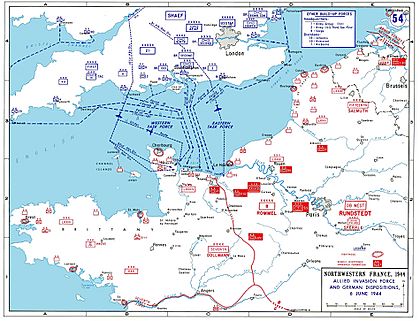
The British planned an airborne attack on the Orne River. Their goal was to capture bridges. This would stop German tanks from using them. It would also prevent retreating Germans from blowing them up. This way, Allied tanks could use the bridges.
British sea attack units would land on Sword and Gold Beaches. The United States had an airborne division and land units. They were to take Omaha Beach, the Pointe du Hoc and Utah Beach. The Canadians would work with British units to attack Sword Beach. The British and Canadians also had their own beaches, Gold Beach and Juno Beach.
The invasion fleet had warships and submarines from eight navies. It was split into two main groups. Admiral Sir Bertram Ramsay led the entire fleet.
Secret Codenames
The Allies gave secret names to different parts of the invasion. Overlord was the name for the entire operation to land on the continent. Getting a strong hold on the area was called Neptune. Neptune started on D-Day (June 6, 1944) and ended on June 30, 1944. By then, the Allies had control in Normandy. Operation Overlord also started on D-Day. It continued until Allied forces crossed the Seine River on August 19, 1944.
German Defenses
The Atlantic Wall
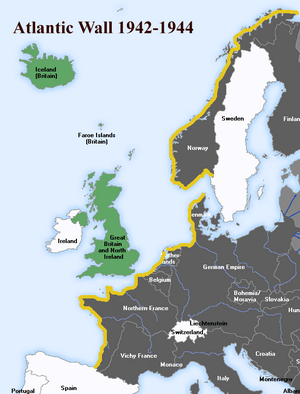
For most of 1942 and 1943, the Germans didn't think the Allies would invade from the west. So, they only built defenses at major ports. By 1944, Germany had 59 army divisions in France, Belgium, and the Netherlands.
Field Marshal Erwin Rommel was put in charge of the "Atlantic Wall." He made the defenses stronger along the coast. They put steel obstacles on beaches. They built concrete bunkers and pillboxes. Low-lying areas were flooded. Pointed stakes were set up in fields to make it hard for Allied planes to land troops. The Germans also fortified the beach areas with tank turrets and barbed wire.
However, these defenses were not finished, especially in Normandy. Allied bombing of French railways made it hard to move building materials. Also, the Allied tricks made the Germans believe the landings would happen in Pas de Calais.
The area that was attacked in Normandy was guarded by four German divisions. Two of them, the 352nd and 91st, were very good. Other defending troops included Germans not fit for fighting on the Eastern Front. There were also Poles and former Soviet prisoners-of-war who had agreed to fight for Germany. These units had German leaders.
Mobile Reserves
Rommel's defense plans were complicated by arguments about how to use armored forces. Rommel wanted tank divisions close to the coast. He thought they should attack invaders while they were still weak. Other German commanders wanted to keep tanks near Paris. They wanted to use them in a large group once the invasion beach was known. Hitler made a compromise.
Rommel was given only three tank divisions. Only one was close enough to fight on the first day. Other tank divisions were controlled by Hitler's army headquarters. They were spread across France, Belgium, and the Netherlands.
Weather Forecast
The invasion could only happen on a few days each month. This was because a full moon was needed. A full moon would give light for aircraft pilots. It would also create a spring tide for landing crafts. Eisenhower chose June 5 as the invasion date. But on June 4, the weather was bad. High winds and rough seas made it impossible to launch landing craft. Low clouds would also stop aircraft from finding their targets.
Weather experts predicted better weather for June 6. On June 5, Eisenhower and his commanders met. Eisenhower decided to launch the invasion that night. If he had waited, the next chance would have been two weeks later. That time was expected to have stormy weather.
The Invasion Begins
Airborne Landings Inland
To make it harder for the Germans to attack during the sea landing, airborne operations were used. Paratroopers were dropped behind the beaches. Their job was to capture bridges and road crossings. They also helped the soldiers landing on the beaches. They destroyed German coastal artillery.
The Beaches
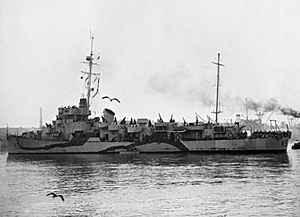
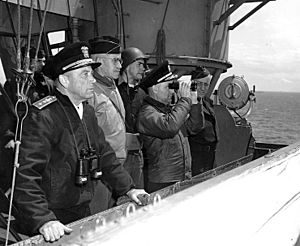
On Sword Beach, British soldiers landed with few problems. They moved about 8 kilometers (5 miles) inland by the end of the day. But they did not reach all of Montgomery's goals. Caen was still held by Germans until July 9.
Canadian forces landing on Juno Beach faced a tough fight. German concrete defenses and a sea wall twice as high as Omaha Beach made it very hard. Juno was the second most defended beach on D-Day, after Omaha. But Canadians were off the beach within hours. They were the only units to reach their D-Day goals. Most units then moved back a few kilometers to stronger defense spots.
At Gold Beach, many soldiers were hurt or killed. This was because the Germans had strongly defended a village on the beach. The British 50th Infantry Division moved almost to Bayeux by the end of the day. When commando units captured Port-en-Bessin, the Allies could use their PLUTO pipeline to bring in fuel.
The Americans on Omaha Beach faced the strong German 352nd Infantry Division. This was one of the best trained groups on the beaches. Omaha was also the most heavily defended beach. Commanders thought about leaving the beach. But small groups of soldiers managed to get past the defenses. By the end of day two, two areas were captured. Control over the beach grew in the next days. The D-Day goals were met by D+3 (three days after D-Day).
At Pointe du Hoc, the 2nd Ranger battalion had to climb 30-meter (100-foot) cliffs. While they climbed, the enemy shot at them and dropped grenades. They used ropes and ladders to climb up and destroy the guns.
These beach defenses were important targets. A single German artillery observer could have directed fire on the U.S. beaches. The Rangers captured the defenses. They then had to fight for two days to hold the spot. They lost more than 60 percent of their men.
The number of dead and wounded on Utah Beach was the lowest of any beach. Only 197 out of 23,000 troops were killed or wounded. The 4th Infantry Division troops on the beach moved inland by early afternoon. They met up with the 101st Airborne Division.
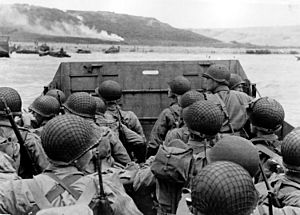
Once the beaches were controlled, the Mulberry Harbours were set up around June 9. One was built at Arromanches by British forces. The other was at Omaha Beach by American forces. Bad storms on June 19 caused problems with supplies. The Omaha harbor was destroyed. The Arromanches harbor could supply about 9,000 tons daily until the end of August 1944. By then, the port of Cherbourg had been captured.
The German 21st Panzer division attacked between Sword and Juno beaches. They almost reached the English Channel. But Allied anti-tank gunners made them pull back before the end of June 6.
The Allied invasion plans called for capturing Carentan, St. Lô, Caen and Bayeux on the first day. The plan was to connect all the beaches. They also wanted a front line 10 to 16 kilometers (6 to 10 miles) from the beaches. None of these goals were met on D-Day. The number of dead and wounded was not as high as some had feared (around 10,000 compared to the 20,000 Churchill had estimated). The bridges also survived German attacks.
Capturing Cherbourg
In the western invasion area, U.S. troops were to take the Cotentin Peninsula. Cherbourg was especially important for its deep-water harbor. The land behind Utah and Omaha beaches had banks and hedgerows. These made it hard for tanks to move and for soldiers to see. This made them perfect for defense.
U.S. soldiers moved slowly towards Cherbourg. They had many dead and wounded. Airborne troops helped with the advance. The far side of the peninsula was reached on June 18. Hitler told German forces not to retreat to the strong Atlantic Wall defenses in Cherbourg. The Cherbourg commander, Lieutenant General von Schlieben, surrendered on June 26. Before surrendering, he destroyed most of the port facilities. This made the harbor unusable until mid-August. By then, the fighting had moved far east, so the port was less useful.
The Battle for Caen

While the Americans went for Cherbourg, British-led troops moved towards Caen. Montgomery launched many attacks to wear down the enemy. The first was Operation Perch. This moved south from Bayeux to Villers-Bocage. Here, tanks could capture Caen. But it was stopped at the Battle of Villers-Bocage. Caen was bombed. Then, it was taken north of the Orne River in Operation Charnwood from July 7 to July 9.
Another attack in the Caen area followed. This was called Operation Goodwood from July 18 to July 21. It involved all three British armored divisions. They captured the high ground south of Caen. Canadian forces captured the rest of the city during Operation Atlantic. A further operation, Operation Spring, from July 25 to July 28, by the Canadians secured limited land south of the city. But it came with many dead and wounded.
Breaking Out from the Beach
Montgomery's plan was to keep the Germans busy in the eastern part of the invasion area. This would protect the American attack called Cobra. By the end of Goodwood, the Germans had used their last reserve divisions. There were six and a half Panzer divisions against the British and Canadian forces. Only one and a half faced the United States armies.
Operation Cobra was launched on July 25 by the U.S. First Army. It was a success. The VIII Corps entered Coutances on July 28. They had broken through the German lines.
On August 1, VIII Corps joined Lieutenant General George S. Patton's Third Army. On August 4, Montgomery changed the plan. He sent troops to take Brittany and push German troops around the ports. The rest of the Third Army continued east. Because many German forces were south of Caen, Montgomery moved British tanks west. He launched Operation Bluecoat from July 30 to August 7. This helped the attacks from the United States armies. This pushed the German forces to the west. It allowed the launch of Operation Totalize south from Caen on August 7.
The Falaise Pocket
By early August, more German reserves became available. German forces were being surrounded. The German High Command wanted these reserves to help them retreat to the Seine. But Hitler demanded an attack at Mortain on August 7. The Allies pushed back this attack. They had been warned by secret code breaking.
The original Allied plan was to surround the Germans as far as the Loire valley. Bradley realized that many German forces in Normandy could not move well. He got Montgomery's approval on August 8 to surround the German forces. Patton was given this task. He moved almost without resistance through Normandy. The Germans were trapped near Chambois. Strong German defense and some American troops being sent to attack towards the Seine prevented the Germans from being fully trapped until August 21. On this date, 50,000 German troops were caught.
The liberation of Paris happened soon after. The French Resistance in Paris attacked the Germans on August 19. The French 2nd Armoured Division under General Philippe Leclerc, along with the U.S. 4th Infantry Division, accepted the surrender of the German forces there. Paris was liberated on August 25.

Retreat to the Seine
Fighting continued in the British and Canadian areas until the end of August. On August 25, the 2nd U.S. Armored Division fought its way into Elbeuf. They met British and Canadian armored divisions there. The 2nd Canadian Infantry Division moved into the Forêt de la Londe on August 27. The area was strongly held by Germans. The 4th and 6th Canadian brigades had many dead and wounded over three days as the Germans defended their position. The Germans pulled back on August 29. They crossed the Seine River on August 30.
On August 30, the 3rd Canadian Infantry Division crossed the Seine near Elbeuf. They entered Rouen to a happy welcome.
Landing Beaches
- Sword Beach was the most eastern beach on D-Day. The British 3rd Infantry Division attacked it. They were supported by units of the 79th Armoured Division. The attack was successful.
- Juno Beach was the next beach to the west. The Canadian 3rd Division attacked it. This attack was also successful.
- Gold Beach was the "middle" beach. It was between Sword, Juno, Omaha, and Utah beaches. The British 50th (Northumbrian) Division attacked it.
- Omaha Beach was the second most western beach. The American 1st Division attacked it. The bombing before the attack worked well on every beach except Omaha. So, German bunkers and artillery were still there. The battle was very hard, but the Americans eventually won. Almost 2,500 Americans died on Omaha Beach.
- Utah beach was the most western beach. It was mostly successful. The American 4th Division attacked it.
End of the Campaign
Historians consider the Normandy campaign to end on different dates. Some say it ended at midnight on July 24, 1944 (when Operation Cobra began). Others say August 25, 1944 (when Paris was liberated). Or August 30, 1944, when the last German unit crossed the Seine River.
The original Overlord plan was for a 90-day campaign in Normandy. The main goal was to reach the Seine. This goal was met early. American forces were fighting in Brittany, as General Montgomery had planned. Historians believe the Normandy campaign ended with the big breakout of Operation Cobra.
The U.S. official history calls the fighting starting on July 25 the "Northern France" campaign. This includes the fighting to close the Falaise Gap. But British, Canadian, and Polish historians see this as part of the Battle of Normandy.
There were reports that Eisenhower wanted to replace Montgomery in July. The slow progress was due to the difficult land. However, Montgomery stuck to his plan to wear down the enemy. He reached his goals within his original 90-day target.
Victory in Normandy was quickly followed by chasing the Germans to the French border. Germany had to send more soldiers and supplies to the Western Front. These came from the Soviet and Italian fronts.
By September, Allied forces were close to the German border. The Allied battle plan was good. It used the strengths of both Britain and the United States. German leadership often made mistakes. But German units fought well.
The Normandy landings also helped the Soviets on the Eastern Front. They were fighting most of the German forces. The invasion helped shorten the war there.
Allied Strengths
Victory in Normandy came from several things. The Allies had more weapons and equipment. They also had new inventions like the PLUTO pipelines and Mulberry harbours. These helped bring in troops, equipment, fuel, and ammunition. Moving supplies over the open beaches went better than expected. This was true even after the U.S. Mulberry harbor was destroyed in a storm in mid-June.
By the end of July 1944, one million American, British, Canadian, French, and Polish troops were in Normandy. Hundreds of thousands of vehicles and many supplies were also there. Artillery ammunition and other items were plentiful. This was amazing, since they didn't have a major port until Cherbourg fell.
By the time of the Normandy breakout, the Allies also had more troops (about 3.5 times more). They also had more armored vehicles (about 4 times more). This helped them overcome the natural advantages the rough land gave to the German defenders.
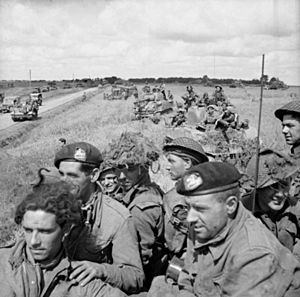
Allied intelligence and counterintelligence efforts were very successful. The Operation Fortitude trick plan before the invasion kept German attention on the Pas-de-Calais. High-quality German forces stayed in that area, away from Normandy, until July. Before the invasion, few German spy planes flew over Britain. Those that did only saw the fake camps. Secret decoding of German Enigma communications also helped. It showed the Allies German plans.
German Leadership Issues
A lack of a clear strategy hurt the German defense. German leaders, Field Marshals von Rundstedt and Rommel, disagreed. Von Rundstedt wanted to keep strong units in reserve. He wanted to launch a powerful counterattack once the Allied landing started. Rommel wanted to stop the Allies right on the beach. He tried to place units so they could attack quickly.
Rommel's plan was good. But the reserve strategy was not. Units could not move during the day because of Allied air strikes. In the end, mixing the two strategies was a disaster. The beach defenses were overcome. The counterattacks were not strong enough.
German commanders at all levels failed to react quickly. Communication problems added to the issues caused by Allied air and naval power. Local commanders did not lead a strong defense on the beach. The German High Command focused on the Calais area. Von Rundstedt was not allowed to use the armored reserve.
When it was finally released late in the day, success was harder. The 21st Panzer Division had attacked earlier. But it faced strong opposition that had grown on the beaches. Overall, even though the Allies had more and more materials, the Germans slowed the Allied advance for almost two months. This was helped by the difficult land.
The Allied commanders had some disagreements. But their plans were decided by the main commanders. In contrast, senior German leaders always had Hitler interfering. He didn't know the local conditions.
Field Marshals von Rundstedt and Rommel repeatedly asked Hitler for more freedom to change plans. But he refused. Von Rundstedt was removed from his command on June 29. This happened after he told Field Marshal Keitel, Hitler's Chief of Staff, to make peace. Rommel was badly hurt by Allied aircraft on July 16.
Field Marshal von Kluge took over from both von Rundstedt and Rommel. He was linked to some military officers who plotted against Hitler. He would not argue with Hitler for fear of arrest. As a result, Hitler pushed the German armies in Normandy to counterattack instead of retreating after the American breakthrough. Kluge was removed from command on August 15 and died by his own hand. The more independent Field Marshal Walter Model then took command.
Images for kids
-
Remains of Mulberry harbour B at Arromanches-les-Bains (Gold) as seen in 1990
-
German troops of the Indian Legion on the Atlantic Wall in France, 21 March 1944
-
Beach obstacles at Pas de Calais, 18 April 1944
-
Canadian soldiers with a captured Nazi flag
-
German forces surrender in Saint-Lambert-sur-Dive, 21 August 1944
-
A British soldier escorts an elderly lady in Caen, July 1944
See also
 In Spanish: Batalla de Normandía para niños
In Spanish: Batalla de Normandía para niños


